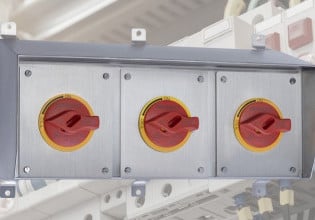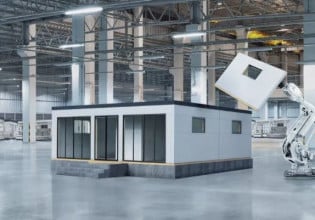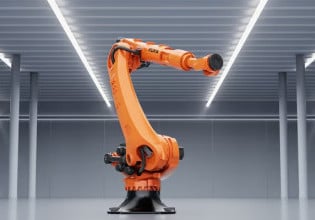Applications of UPS (Uninterruptible Power Supply) in Control Systems
Learn about some common implementation strategies of UPS in control systems and important design considerations.
Uninterruptible power supplies are far more present in industrial automation systems than many realize. Any control panel with a well-designed power protection framework will include an uninterruptible power supply (UPS) as its key component.
Server rooms, industrial PCs, mobile applications (stacker cranes, AMR's), and others may also include a UPS. Features such as overall dimensions, power capacity, and switching time vary depending on the application. The following sections describe UPS usage for each type of control system.
Uninterruptible Power Supply in Control Panels
A control panel contains specific control devices in an automated system such as PLCs, HMI's, motion drives, safety sensors, network switches, among many others. Even with decentralized systems, the power source for the embedded control hardware comes from the main panel.
These control devices require a 24 Volt DC power input and, typically, they also consist of sensitive components and microprocessors. Due to this, good power supply quality is crucial to avoid downtime caused by disruptions or hardware damage. A 24V DC UPS can manage voltage fluctuations, frequency distortions. These short outages and provide a clean and reliable supply to the control system.
With its backup battery pack, a DC UPS designed for an industrial environment will be more resistant to harsh external conditions. It will also need to comply with norms such as UL 508 and other requirements stipulated by the FCC (FCC 13-158), and the unit will have the ability to be mounted on a DIN rail.

Fig. 1. A control panel equipped with a DIN rail mounted UPS from Cyber Power (bottom row). Image used courtesy of Cyber Power Systems
Remote monitoring has become an important trend in UPS design. Many major brands of UPS come with the option to interface the device with external systems via Ethernet or some other protocol.
Knowing the backup power system's status is essential to validate the redundancy provided by the UPS is working correctly. It can also help track and record historical data about power consumption and other related variables to plan preventive maintenance.
For some, the fact that the UPS is technically monitoring itself could be perceived as unreliable. For this reason, there are also external monitoring devices capable of integrating with different UPS brands, and that constitutes a sort of external auditor to the power supply system. These external devices are normally paired with a software package that includes reporting, statistics, and current status. Regardless of the infrastructure used, having the option to remotely monitor a UPS can increase the reliability of a control system.
Mobile Applications
This refers to conveyance equipment and other control applications where motion is involved or programmed using state machine logic. In addition to the characteristics and advantages mentioned in the previous section, a DC UPS has an additional benefit when used during a prolonged power outage.
This is the capability of returning the control system or machine to a known state and then manage a soft shutdown. Status outputs from the UPS can be fed to the PLC to understand when the system is in a prolonged outage condition and then prepare to ramp down the moving components and bring them to a safe stopping point.
Examples of this are automated stacker cranes used in automated storage and retrieval systems (ASRS), autonomous mobile robots (AMR's), and high-speed belt conveyors. This also improves the overall safety of a system by minimizing the risk of spills or collisions that could otherwise be caused by sudden, unexpected stops.

Fig. 2. A stacker crane inside an ASRS can be equipped with a UPS to help the machine return to a safe state during a power outage. Image used courtesy of SICK
Complimentary to a safe shutdown process is the orderly restart of a control system once the power supply is restored. Besides the dynamics aspect, a proper shutdown ensures that the PLC or IPC can save the status of temporary variables and log and buffer events that could need to be reported to outside systems after power is back. An AMR, for example, can save its last known coordinates before turning off and then later can send that to the traffic controller during the restart.
One particularity of automated logistics systems, such as AMR's and laser-guided vehicles, is that the main power supply of the control system is also a battery. The same principles and advantages of using a DC UPS apply. A battery is subject to very similar voltage fluctuations and harmonics distortions to those from a utility supply.

Fig. 3. The SITOP DC UPS from Siemens is one of the major UPS models used in control systems. Image used courtesy of Siemens
Depending on the operation being executed by the automated vehicle, abnormally high current draws could occur, and that can be regulated by the UPS.
Server Rooms
This is where the border between control systems and IT infrastructure exists. When thinking of server rooms dedicated to running the higher-level applications within a control system, many of the same considerations for high availability and shutdown/restart protocols apply.
The notion is that these servers, which can be virtual machines residing within the physical infrastructure, need to work together with the PLC/IPC automation and be in synchrony during an outage event.
Many Windows or Linux-based applications can use protocols such as OPC in order to communicate with PLCs. During an outage, they need to coordinate the shutdown procedure to arrive at a safe stopping point.
In the case of the applications, the focus could be more on logging power fault information, coordinating the moving conveyance equipment has safely stopped, storing SKU or other product information, and saving data in a database.

Fig. 4. An example of a server room equipped with power failure management with a UPS arrangement. Image used courtesy of Sensaphone
In many highly automated systems nowadays, the level of integration continues to increase. This applies to power and power failure management as well. The ability to remotely monitor these factors is now considered crucial as well.
From the more simple embedded control systems to the server racks in a server room, all parts of the system should be equipped with UPS infrastructure to achieve higher system reliability.






